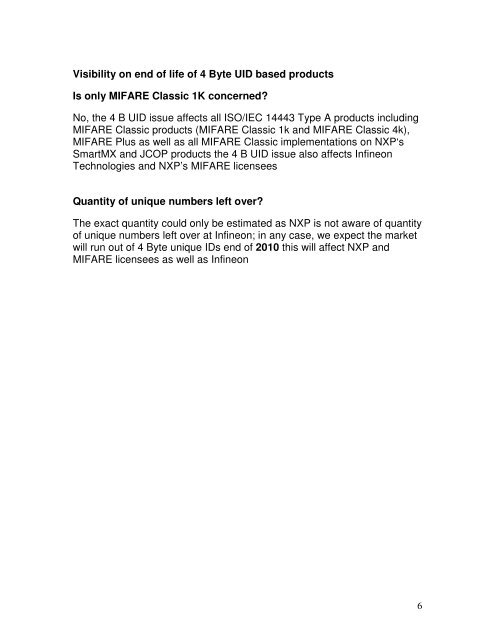4 Byte and 7 Byte UID offering for MIFARE Classic™, MIFARE Plus ...
4 Byte and 7 Byte UID offering for MIFARE Classic™, MIFARE Plus ...
4 Byte and 7 Byte UID offering for MIFARE Classic™, MIFARE Plus ...
Create successful ePaper yourself
Turn your PDF publications into a flip-book with our unique Google optimized e-Paper software.
Visibility on end of life of 4 <strong>Byte</strong> <strong>UID</strong> based products<br />
Is only <strong>MIFARE</strong> Classic 1K concerned?<br />
No, the 4 B <strong>UID</strong> issue affects all ISO/IEC 14443 Type A products including<br />
<strong>MIFARE</strong> Classic products (<strong>MIFARE</strong> Classic 1k <strong>and</strong> <strong>MIFARE</strong> Classic 4k),<br />
<strong>MIFARE</strong> <strong>Plus</strong> as well as all <strong>MIFARE</strong> Classic implementations on NXP‘s<br />
SmartMX <strong>and</strong> JCOP products the 4 B <strong>UID</strong> issue also affects Infineon<br />
Technologies <strong>and</strong> NXP’s <strong>MIFARE</strong> licensees<br />
Quantity of unique numbers left over?<br />
The exact quantity could only be estimated as NXP is not aware of quantity<br />
of unique numbers left over at Infineon; in any case, we expect the market<br />
will run out of 4 <strong>Byte</strong> unique IDs end of 2010 this will affect NXP <strong>and</strong><br />
<strong>MIFARE</strong> licensees as well as Infineon<br />
6









